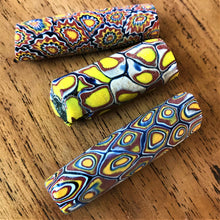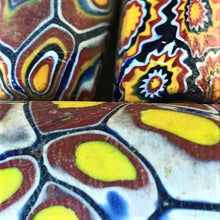Often referred to as love or hippy beads, they’ve also been called slave beads, thousand flower beads, or mosaic beads, these 250-year old Venetian millefiori (thousand flowers) glass beads are better known as African Trade Beads.
This is why these well-travelled and well-worn trade beads have some minor scratches and tiny chips, but regardless, they are fast becoming rarer by the day.
That said, for beads this age they’re in pretty good nick and have maintained their vivid colours throughout time.
Well-worn and fast becoming rarer by the day, this collection of three Venetian millefiori (thousand flowers) glass beads are commonly referred to as African Trade Beads and believed to be up to 250 years old.
Made by using several multicoloured glass rods or canes, known as murrine as some would prefer, the millefiori technique calls for the murrine to be fused by heat and embedded into a matrix. At this point, the outside looks quite plain, but once cut open will exposes a detailed flower pattern.
Ever since the late 1700s, these pretty little things have generated enormous appeal for their beauty and have been used as currency for centuries as well as a status symbol.
In Africa, also known as the plateau continent, the early European traders used them to trade for a multitude of items including slaves, ivory, gold, fabric, palm oil, and food right up to the mid-1920s.
The beads enjoyed a bit of a revival in the 1960s when many of the young people of the day (often referred to as hippies) started to travel and roam the globe like never before. Drawn by the sheer beauty and colours of the millefiori beads, many have since found their way into private collections or used in the construction of ethnic-styled jewellery.
We understand these particular beads tend to appreciate with time, rather than depreciate – which makes them a great investment – especially at $40 each.




